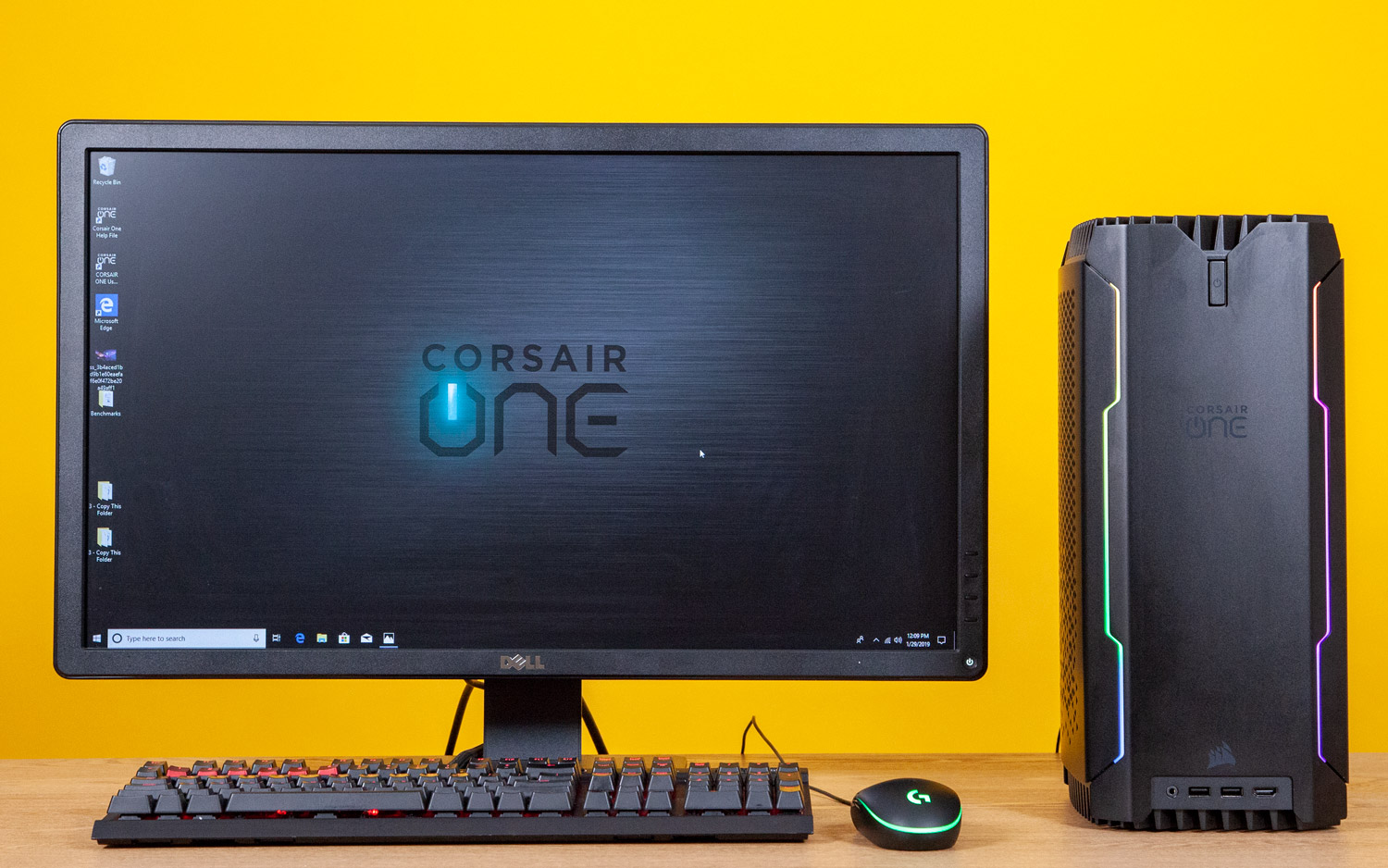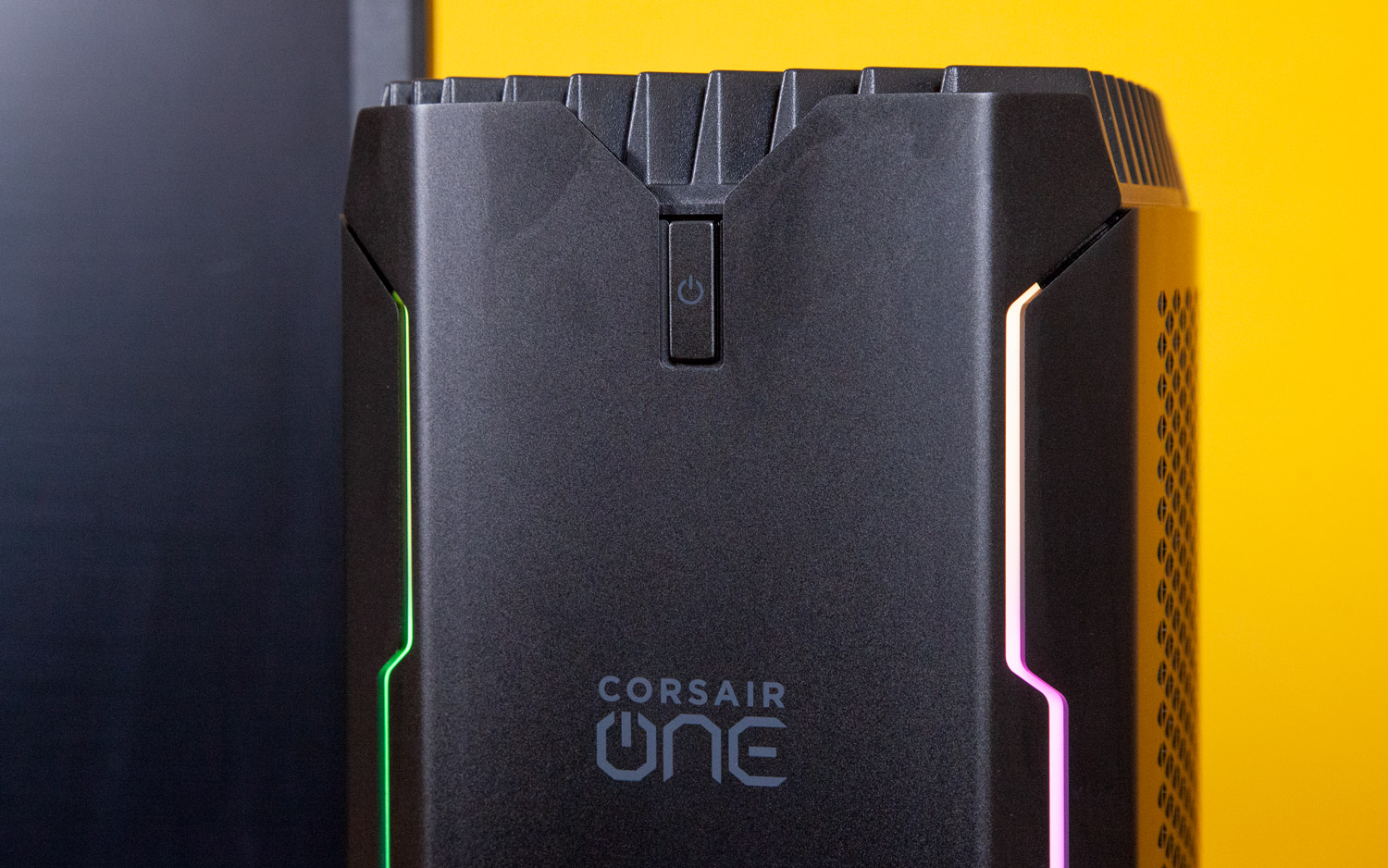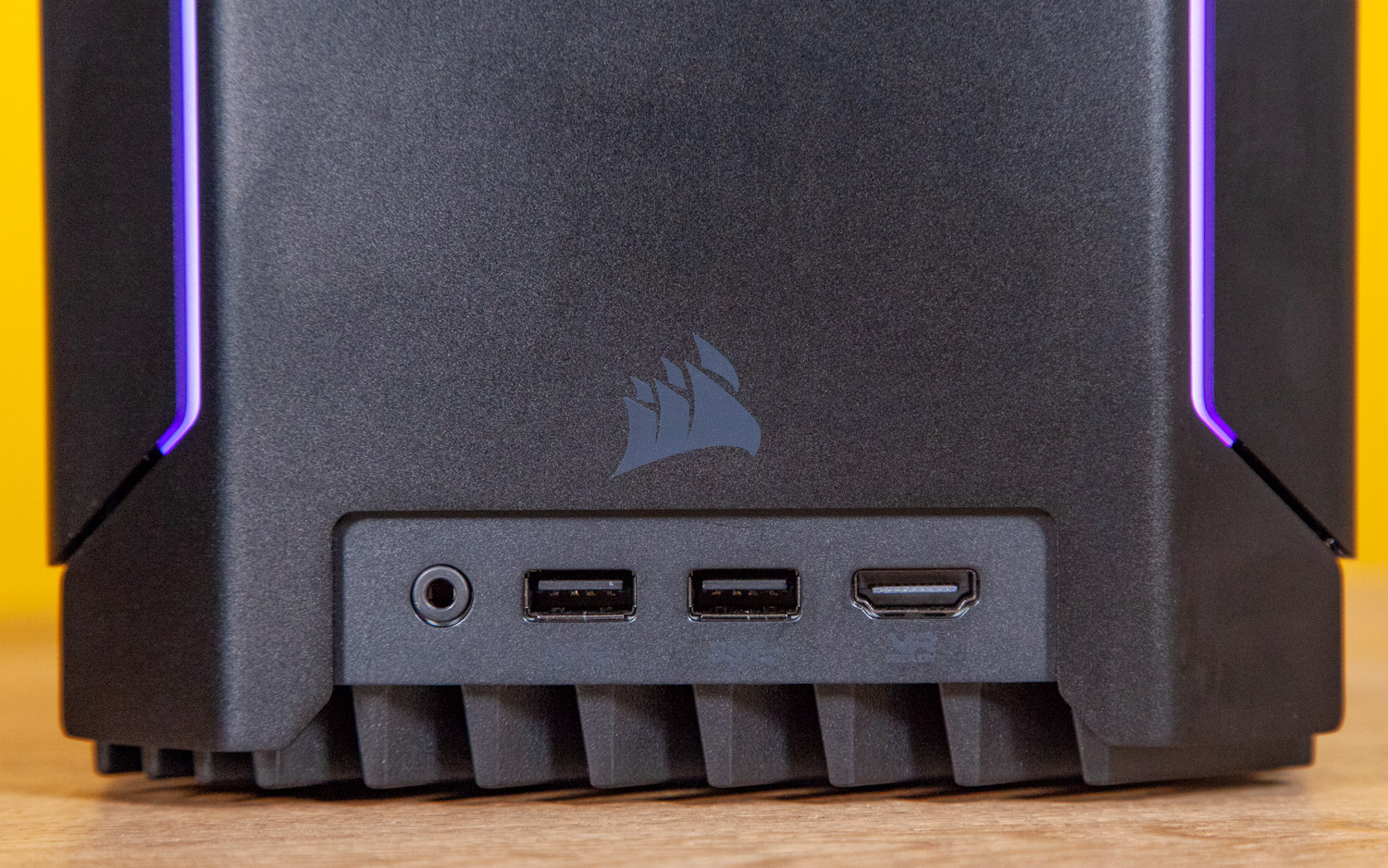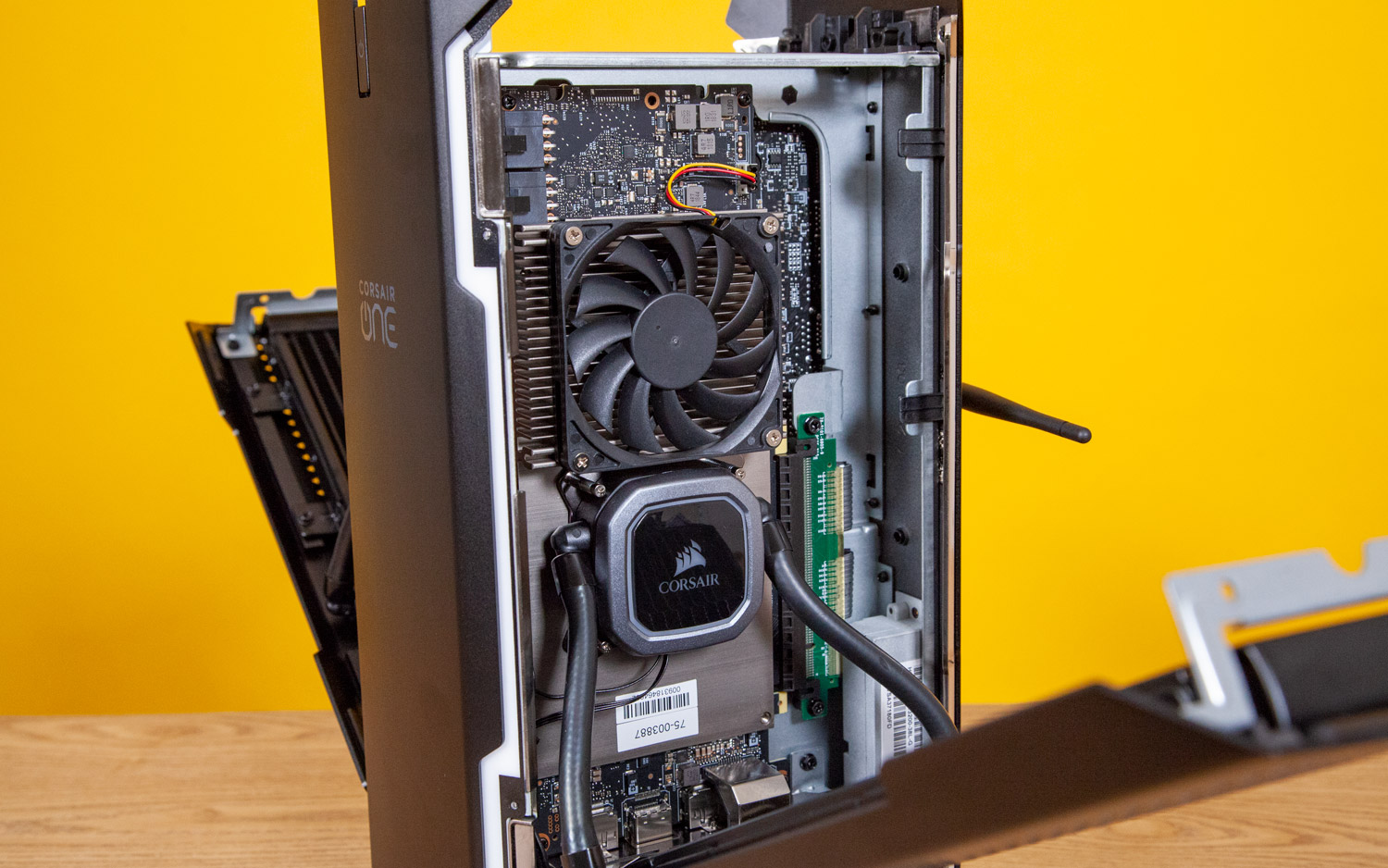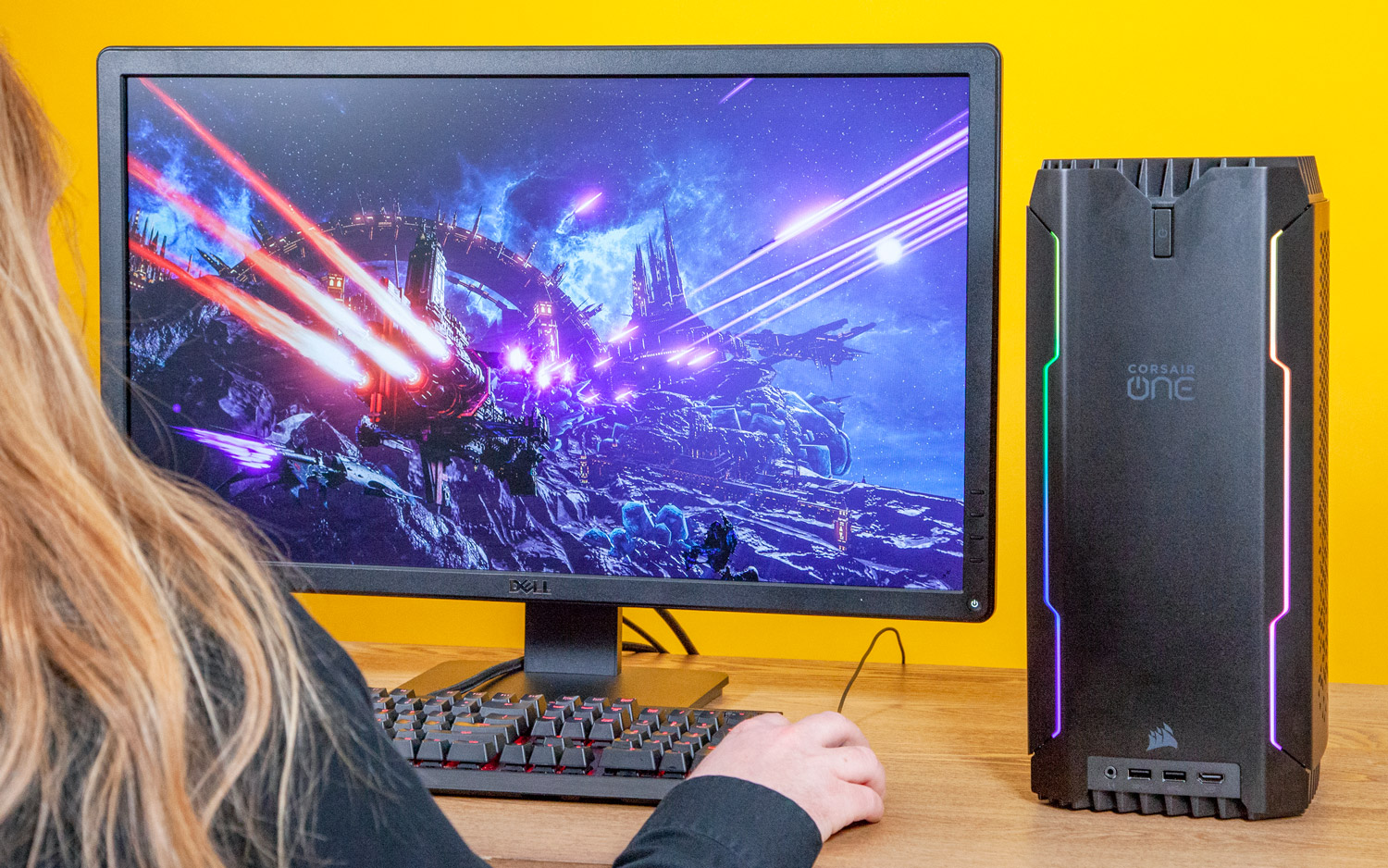Tom's Hardware Verdict
Corsair made a great compact PC even better with the One i160. With top-of-the-line components, an impressively small footprint and surprisingly quiet performance, our only reservation is the steep asking price.
Pros
- +
Top-end components and performance in a sleek, compact shell
- +
Surprisingly quiet operation
Cons
- -
Limited (and complicated) upgradability
- -
Expensive at every configuration level
- -
Uses older Z370 chipset
Why you can trust Tom's Hardware
The days of the massive tower PC may be numbered. Both Nvidia and AMD are de-emphasizing multi-card gaming setups, due in part to limited game support. Storage is getting denser and cheaper seemingly by the day. And if Corsair’s One line of compact PCs are any indication, bulky cooling setups with lots of fans are no longer necessary to keep the temperatures of high-powered components under control.
Corsair’s revamped One i160 looks nearly identical to the previous Corsair One model on the outside, save for the aesthetic addition of RGB in the light strips that run down its compact 12-liter frame. But with a redesigned internal layout that the company says has increased the airflow by a factor of three, this already impressive compact powerhouse takes pint-sized performance computing to another level.
One of the best gaming PCs you can buy, Corsair’s updated One i160 packs in the most powerful mainstream CPU (an Intel Core i9-9900K) and the fastest consumer-focused graphics card (the Nvidia RTX 2080 Ti) into a tall-but-small tower that remains impressively quiet considering its top-shelf performance parts. It’s certainly no impulse buy at $3,599 (£3,399.99). But if you want a powerhouse gaming and productivity PC and don’t have the room for a traditional tower, you’d be hard-pressed to find a more compact and refined alternative.
Design
At first glance, the Corsair One i160 looks nearly identical to its previous-generation One counterpart. But aside from the shift to addressable RGB lights on the front (controlled by the pre-installed Corsair iCue software), the internal layout has changed quite a bit.
For starters, the power supply has moved to the bottom, which in theory should help with what Corsair calls “convection-assisted” cooling, and means you don’t have to remove the top to detach the power cable. I’d argue that moving the power cable to the bottom also makes for a more stable design; any accidental yanks on the cable are less-likely to topple the tower if its power tether is near the floor.
As for the light pipes that run down the front of the system, they default to blue out of the box. But firing up the company’s iCue software, you can customize the color of the eight total LEDs (four in each strip), or have them change based on temperature changes or what game you’re running.
The 7.9 x 7-inch (200 x 176 mm) footprint remains the same as the previous model, but that doesn’t make it any less impressive that Corsair managed to fit top-tier components in such a small space.
Get Tom's Hardware's best news and in-depth reviews, straight to your inbox.
Specifications
| Processor | Intel Core i9-9900K |
| Motherboard | Custom MSI Z370 mini-ITX |
| Memory | 32GB (2x16GB) Corsair Vengeance LPX DDR4-2666 |
| Graphics | Liquid-cooled NVIDIA GeForce RTX 2080 Ti (11GB GDDR6) |
| Storage | 480GB M.2 NVMe; SSD 2TB 2.5” SATA HDD |
| Optical Drive | N/A |
| Networking | 802.11ac 2x2 Wi-Fi, Gigabit Ethernet |
| Interface | Front: 2x USB 3.1 Gen 1; Combination Mic/Headphone Jack;Rear: PS/2, 2x USB 2.0, USB 3.1 Gen 2 Type-C, USB 3.1 Gen 2 Type-A, 2x USB 3.1 Gen 1, 7.1 Surround Audio, 3x DisplayPort |
| Video Output | (3) DisplayPort 1.4; (1) HDMI 2.0 |
| Power Supply | 600W Corsair SF600 SFX 80 Plus Gold |
| Case | Corsair One Aluminum/Steel |
| Operating System | Windows 10 Home 64-Bit |
| Dimensions | 7.9 x 7 x 15 inches (200 x 176 x 380 mm) |
| Price As Configured | $3,599 (£3,399.99) |
Ports and Upgradability
You won’t quite get the same amount of ports here that you would expect with a larger desktop, but there’s still enough for most users. On the front near the bottom you’ll find a headphone/mic combo jack and a pair of USB 3.1 Gen1 Type-A ports, along with an HDMI 2.0a port, which is handy for plugging in a VR headset.
Around back lives a PS/2 port for legacy (some would say ancient) peripherals, a pair of USB 2.0 ports for more modern mice and keyboards, as well as a pair of USB 3.1 Gen 2 ports (one Type-A and one Type-C). Below that sits another pair of USB 3.1 Gen 1 ports and Gigabit Ethernet, along with attachment points for the included Wi-Fi antennas, and the usual assortment of digital and analogue audio connectors.
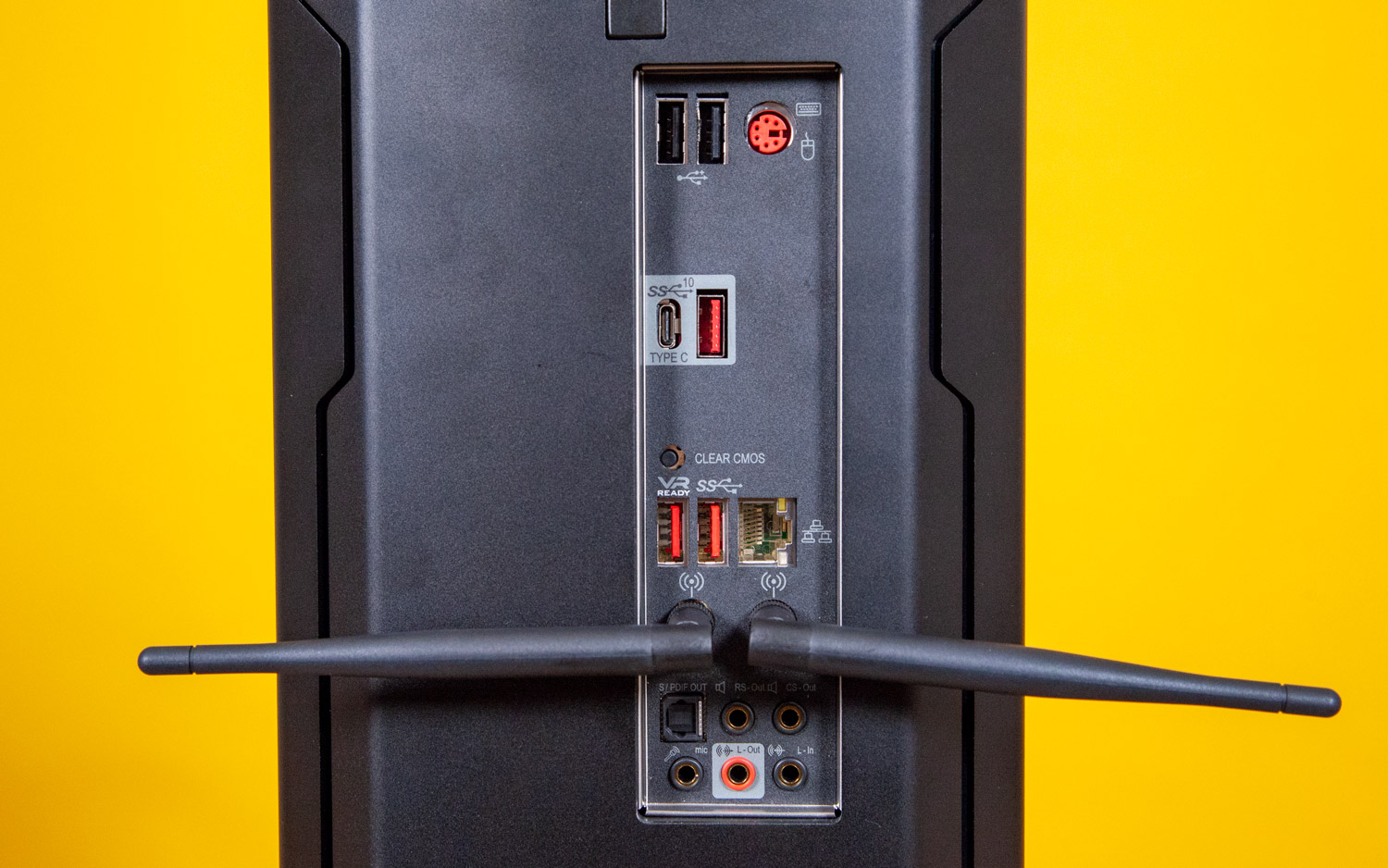
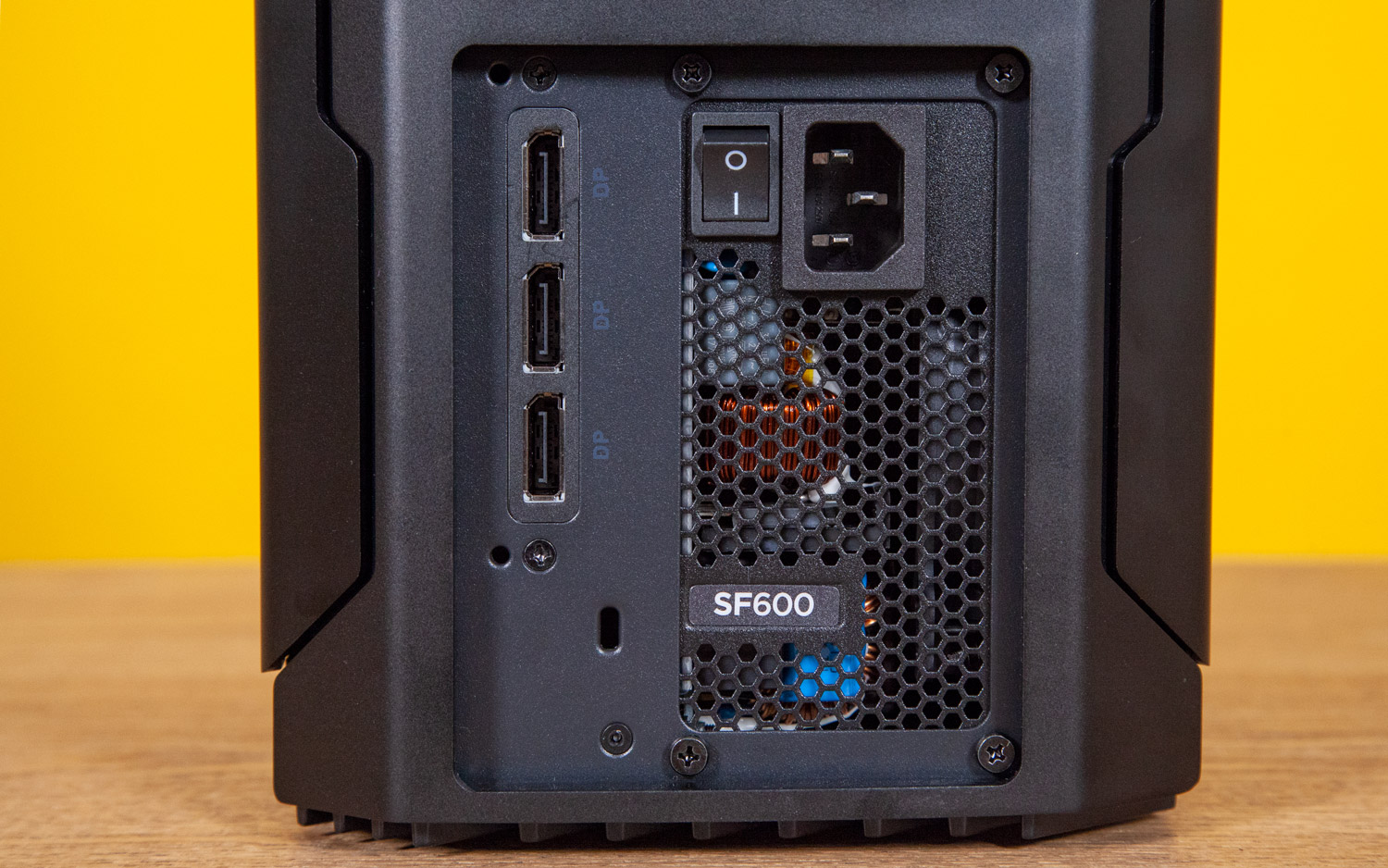

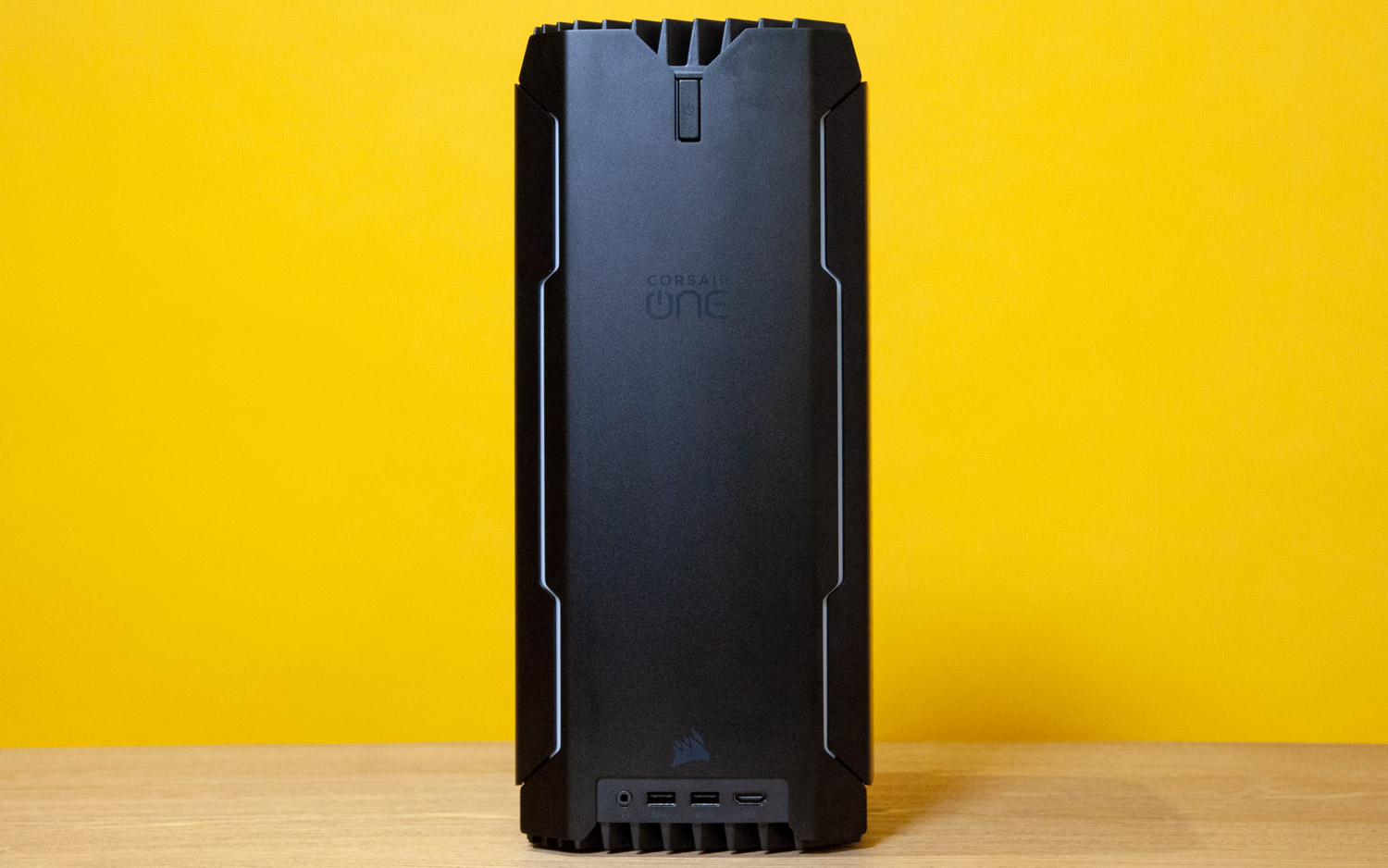
For video connectivity, aside from the front-facing HDMI 2.0a port, you get three DisplayPort 1.4 ports. The only glaring omission here is the lack of a VirtualLink/USB-C port for future VR headsets. While there aren’t yet any headsets available that take advantage of this port, it exists on most Nvidia 20-series graphics cards, so it might be a feature you’ll regret missing out on in the future, should you delve into the realm of VR gaming.
Also, the system employs a MSI motherboard that uses a now-technically outdated Z370 chipset. That’s mostly fine, since the main advantages of the newer Z390 chipset are better integration of USB 3.1 Gen 2 and Wi-Fi. But considering the cost of the i600, some may balk at not having the latest and greatest chipset. And had Corsair stepped up to a Z390 motherboard, there likely would be more than just two speed USB 3.1 Gen 2 ports.
As for internal upgradability, you can get at most of the parts if you’re comfortable dismantling expensive PC hardware. But you can’t add any RAM or storage without swapping out what’s already there. And getting at the boot drive will involve removing the graphics card and its liquid cooling. Let’s take a look inside the revamped Corsair One i160.
As with the previous model, you’ll have to start by pressing a button on the back near the top to pop off the system’s lid to open it. Note that this button needs to be pressed very hard, and that you’ll then have to unplug the fan from its standard four-pin connector to remove the lid from the system.
From there, to access the rest of the system you’ll have to remove two screws from each side. Be careful, though, as the radiators are attached to the side panels, and remain tethered by the coolant tubes.
It’s fairly easy to remove the RAM, although the 32GB of Corsair Vengeance LPX DDR4-2666 occupies both of the slots and should be sufficient for gaming and most mainstream computing purposes. The 2TB Seagate 2.5-inch hard drive is also accessible from the front. But there’s no room for adding extra storage. And the 480GB Samsung NVMe SSD is mounted to the back of the motherboard. To get to that, you’d have to remove the graphics card, which I didn’t attempt to do.
Corsair says the graphics card is also technically replaceable with an air-cooled card (using axial rather than blower-style cooling). The company says you can decouple the graphics cooling setup from the CPU cooler and install a different card (so long that it fits within the physical restraints of the case). But the bottom line is this system already comes well equipped with the best consumer-level CPU (Intel’s Core i9-9900K) and gaming GPU (Nvidia’s GeForce RTX 2080 Ti) that you can currently buy.
The only thing I’d do differently if configuring a similar system myself is get a roomier boot SSD. Fast 1TB NVMe SSDs are now priced in the $250 range, with some selling for much less. Given $3,600 asking price of this system, spending more on the drive you’re going to want to install all your important games and programs on is warranted--especially since it’s not exactly easy to swap out the boot drive on this system.
Gaming, Graphics and VR
Given what we already know about the RTX 2080 Ti and the Core i9-9900K (in case you aren’t paying attention, they’re the fastest gaming graphics card and gaming CPU available), it’s no surprise that the Corsair One i160 excels at gaming and can pretty much handle any title at 4K (3,540 x 2,160 resolution).
I played through some of the Argent Tower boss sequence in Doom at 4K and Ultra settings and the frame rates hovered between 103 and 137 fps. During that testing, the One i160s cooling system got noticeably louder. But that’s in part because it’s silent the vast majority of the time.
At the default fan settings during gaming, fan noise is more of a soft whir than the kind of pronounced blowing sound I’m used to from most compact gaming towers I’ve tested in the past. Even with cooling set to the Extreme setting in the iCue software, fan noise was still relatively muted. That’s no doubt in part due to the fact that most of the device’s heat is radiated through the radiators on the sides. The 140mm fan in the top definitely exhausts heat, but it since it isn’t doing the bulk of the cooling, it doesn’t need to spin very fast.

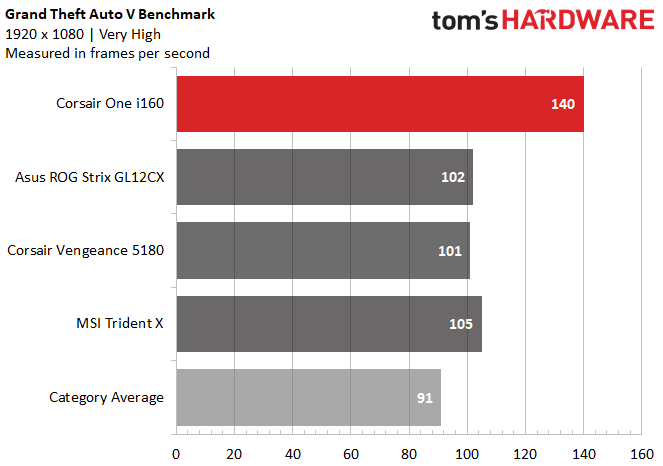

The One i160 is actually the first RTX 2080 Ti-equipped desktop we’ve tested, so it easily bested our 2080-packing counterparts in our benchmarks. In Rise of the Tomb Raider at 1080p, the One i160 delivered a frame rate of 123, far besting the gaming desktop average of 93 frames per second (fps), as well as everything else on our charts. 4K performance wasn’t quite as impressive, but the One i160 still managed 45.3 fps.
Grand Theft Auto V delivered similar numbers for the One i160, with 45 fps at 4K and 140 fps at 1080p. Again, that’s 53 percent above the 91 fps gaming desktop average. And our RTX 2080-equipped competition struggled to get much above the 100 fps mark.
Corsair’s One i160 ran Hitman (3840 x 2160, Ultra settings) at 96 fps, again easily beating the gaming desktop average and the competing machines.
The One i160 also handled the new Shadow of the Tomb Raider with ease, delivering 123 fps at 1920 x 1080 and 47 fps at 3840 x 2160. And given lesser machines with RTX 2080s have previously scored a perfect 11 in the Steam VR benchmark, it’s no surprise to see the i160 deliver the same score.
On our stress test, in which we run Metro: Last Light 10 times in a row the One i160 Core i9-9900K averaged a clock speed of 4.6 GHz and a temperature of 55.3 degrees Celsius (131.5 Fahrenheit). The GPU temperature averaged 57.2 degrees Celsius (135 Fahrenheit). Both temperatures are well within the tolerances of the respective silicon, so there should be no throttling issues while gaming.
Productivity Performance
Despite its small size, the Corsair One i160 is still a powerhouse PC, with its Core i9 processor, RTX 2080 Ti graphics, 32GB of RAM and NVMe SSD. Unsurprisingly, it plowed through average workday tasks like word processing and photo editing with ease. But on these tests, the Corsair system faces stiff competition from Asus’ ROG Strix GL12CX, a bigger mid-tower that has the same Core i9-9900K processor.
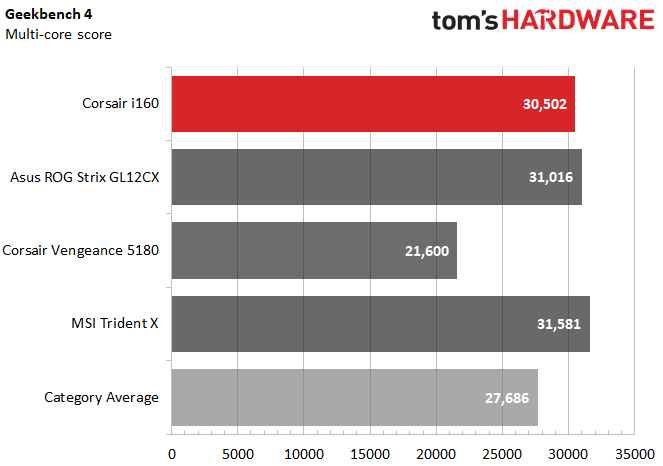
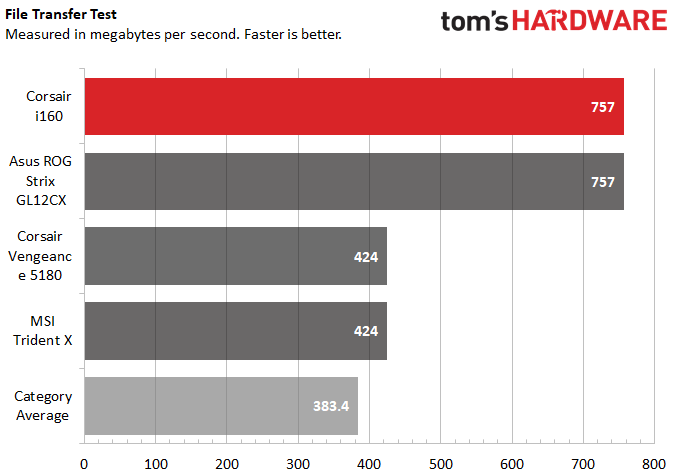

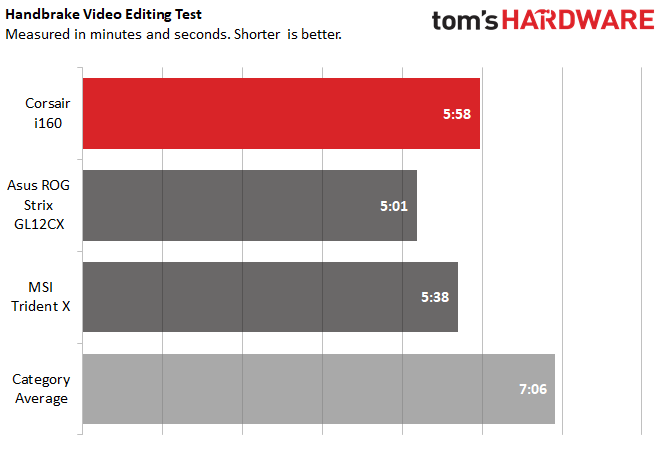
On Geekbench 4, the GL12CX earned a score of 31,016, which just edged out the Corsair i160. But both systems land ahead of the gaming desktop category average on this test.
The One i160 evenly matched the Strix GL12CX in the 4.97GB file transfer test, averaging 757 MB per second. Both systems sport NVMe storage drives, which help catapult them well above the 383.4MBps category average.
It took 25 seconds for the One i160 to pair 65,000 names and addresses in our Excel macro test, a second behind the ROG Strix GL12CX and even with the MSI Trident X. All three systems here easily surpassed the gaming desktop average of 34 seconds.
On our Handbrake test, in which we use the program to transcode a 4K video to 1080p, the Corsair i160’s time of 5:58 fell noticeably behind the Strix GL12CX (5:01) and the Trident X (5:38). This may be an indication that One’s thermal setup, while sufficient for gaming, may not excel at keeping the notoriously power-hungry Core i9-9900K cool under sustained workloads. Of course, ramping up the fan preset over the default standard settings should help on that front as well.
Software and Warranty
The Corsair One ships with two years of warranty coverage and very little in the way of pre-installed software. Aside from Windows 10 Home and the bloatware that comes with every Windows machine, you get the previously mentioned iCue software, which can be used to control both the lights as well as the system fans. And the company also includes PC Doctor for remotely diagnosing performance and / or hardware issues.
Configurations
Corsair now offers the One in three configurations. The One i140 is the “entry level” option, selling for $2,999 (£2,849.99) with an eight-core, eight-thread Core i7-9700K and Nvidia GeForce GTX 2080 graphics. Our i160 is the mid-tier option with an eight-core, 16-thread Core i9-9900K. And while it’s not quite available as of this writing, Corsair will also sell an i180 Pro model aimed at content creators, with a 12-core, 24-thread Core i9-9920X and an Nvidia GTX 2080 Ti, priced at $4,999 (£4,749.99). All three models ship with 32GB of Corsair’s Vengeance LPX DDR4-2666 RAM and a 2TB hard drive. The Pro model also has a 960GB NVMe SSD, while the two lesser models offer up just 480GB of NVMe storage.
Ideally, we’d like to see an even lower-end model with a Core i5 (or a lesser Core i7) and and an RTX 2070. But clearly Corsair wants to target the high-end of the gaming and enthusiast market with its compact One PCs. For those looking to spend less, the company also offers the Corsair Vengeance 5180, which starts at $2,399.
But the company isn’t charging a huge premium for the parts and the compact design. When I wrote this, I priced out a system with similar components (in a bigger case), and the build budget ran to just under $3,000 with an air-cooled RTX 2080 Ti. Stepping up to a liquid-cooled card adds about $500 to the price, which almost gets you to within $100 of the i160’s $3,599 asking price.
Bottom Line
Corsair managed to take its already impressive One desktop, redesign its internals and drop in today’s top-end components while keeping temperatures and fan speed under control. In fact, the One i160 is the quietest compact performance desktop in recent memory, producing noise levels we’d be pleased with from a similar system in a much larger case.
There’s little to complain about save for the steep $3,599 asking price. But when you add of up the cost of the components--particularly a liquid-cooled RTX 2080 Ti, you’d wind up paying nearly as much if you built a similar (larger) system yourself. I still think the Core i9-9900K is overkill for a gaming CPU, as is the RTX 2080 Ti unless you plan on gaming in 4K.
As such, the lesser $2,999 One i140 is probably a better buy for most people as it’s still a very powerful configuration with the same 32GB of RAM and 480GB SSD, but with a Core i7 CPU and a non-Ti RTX 2080. I’d still like to see more spacious solid-state storage in systems this expensive, given how much the cost of 1TB SSDs have come down.
But if you’re after a slick, powerful PC for gaming and productivity work that takes up minimal desk space and won’t drown out your work and play with loud fans, Corsair’s revamped One lineup should be at the top of your list.
MORE: Best Gaming Desktops
MORE: How To Build A PC
MORE: All PC Builds Content
Photo Credit: Tom's Hardware
After a rough start with the Mattel Aquarius as a child, Matt built his first PC in the late 1990s and ventured into mild PC modding in the early 2000s. He’s spent the last 15 years covering emerging technology for Smithsonian, Popular Science, and Consumer Reports, while testing components and PCs for Computer Shopper, PCMag and Digital Trends.
-
2Be_or_Not2Be I enjoy building my own PCs. At the price point quoted for these Corsair ONE systems, I will continue to enjoy building my own PCs.Reply -
delaro Overpriced for the hardware, The niche of having a small form factor doesn't mean you need to charge $1000+ more.Reply -
islandwalker @2BE_OR_NOT2BE and @DELARO You should re-calculate your prices. As noted in the review, I parted out a similar build with a $160 case and it's either nearly $3,000 for these components with an air-cooled RTX 2080 Ti, or $3,500 with a liquid-cooled card (a better comparison to this system. Corsair isn't charging $1,000 for the form factor, or even half that. These parts are expensive.Reply
I do wish Corsair made a lesser version with a 2060 or 2070 and a Core i5, though. -
mischon123 I think the Corsair Carbide 240 Air would be a better choice for a Corsair build than this cramped mess. Its lower and slightly wider.Reply -
cryoburner How are those gaming performance numbers measured? The 4K results in particular seem quite low compared to those listed in the 2080 Ti review, and most other performance numbers I've seen for this card.Reply
While I agree that it might be a good thing to add for convenience, it's unlikely to be a requirement for VR devices anytime soon. So far, VirtualLink only appears on Nvidia's 20-series cards, and is only common on the high-end ones. Almost no RTX 2060s bother to include the port, so it seems unlikely to appear on their more mid-range to lower-end offerings either. It will be years before a reasonable portion of gaming systems have VirtualLink. VR headset manufacturers are not going to limit their audience to those with support for that connection when so few people have it, so it's reasonable to assume that they will continue to support connecting their devices via multiple cables, as they do now. The cable coming from the headset may switch to USB-C, but a little box converting that to separate USB, video and power cables will likely continue to be included.21728961 said:The only glaring omission here is the lack of a VirtualLink/USB-C port for future VR headsets. While there aren’t yet any headsets available that take advantage of this port, it exists on most Nvidia 20-series graphics cards, so it might be a feature you’ll regret missing out on in the future, should you delve into the realm of VR gaming.
Of course, this system doesn't appear to have HDMI in back either, so one might need wires running around to the front if the headset doesn't support DisplayPort. And the limited number of USB ports might be more of a concern with existing headsets. The Oculus Rift uses 3 to 4 USB ports for the headset and tracking cameras, though that will likely change with their next-generation devices. At least the system has PS/2 though, in case someone has a 90s-era mouse that they want to connect to their enthusiast-level gaming system. : D
On the other hand, it's becoming harder to shrink components and improve efficiency of chips, so unless there's some major breakthrough in chip design, eventually we're going to reach the point where if you want more performance, you might need to go larger. Although I suppose if the parts are not getting significantly faster from one year to the next, upgrading an already high-end system might be less of a concern. And if the system isn't built around being user-serviceable, you can get away with more compact designs like this. That first photo is a bit misleading though, since initially I thought the system might have fancy gull-wing doors with hydraulics for easy access to the internals. Instead, it's quite the opposite, and accessing anything inside is significantly more complicated than with a typical case.21728961 said:The days of the massive tower PC may be numbered. Both Nvidia and AMD are de-emphasizing multi-card gaming setups, due in part to limited game support. Storage is getting denser and cheaper seemingly by the day. And if Corsair’s One line of compact PCs are any indication, bulky cooling setups with lots of fans are no longer necessary to keep the temperatures of high-powered components under control.
Price-wise, eh... It's rather high for a gaming system, but then again I would consider the 2080 Ti and 9900K to be overpriced themselves, so it stands to reason that anyone willing to put them in a gaming system might not care so much about paying a bit extra for it. I can see where the others are coming from about the pricing though, as it should be possible to put together a build offering the same level of performance for significantly less, so long as we ditch the small form factor. Sure, we're also not using a water-cooled graphics card, but you shouldn't need a water-cooled card in a regular ATX case. So yeah, you're paying a lot for the form factor. It's cool that they managed to pack that level of hardware into such a small case, but ultimately, how much benefit does a small case provide for a desktop PC?
-
chill1221 Am I the only one that watches blu-rays on my computer? Needs an optical drive IMHO!Reply -
punksmurph I have the original that I purchased discounted late last year. I love it. The machine is quiet and about the cost I would have paid to get the components in a small tower. This sits on my desk behind the monitors and is almost silent. If these get a little lower in price late this year I may impulse upgrade.Reply -
photonboy APPLE has an amazing design for their similar looking Mac Pro (the black "garbage can") thing. It has a massive heatsink at its core which the two GPU's and CPU attach to and a single fan moves the air up through like a chimney. It's damn quiet too.Reply
